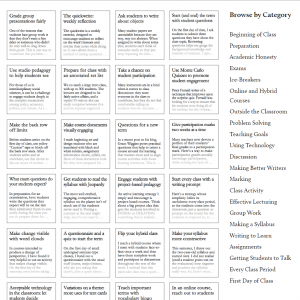For many of us this time of year marks the beginning of a new semester. Even if your classes have already started up, it’s not too late to consider some tips for improving the teaching and learning experience in your classroom. James M. Lang, professor of English and director of the Center for Teaching Excellence at Assumption College in Worcester, Massachusetts, has written two articles in a proposed series for The Chronicle of Higher Education “…making the argument in this space that small changes to our teaching — in things like course design, classroom practices, and communication with students — can have a powerful impact on student learning.”

CC Photo by Creative Services: http://spirit.gmu.edu/wp-content/uploads/2013/05/student-presentation-ncc.jpg
In the first article, Small Changes in Teaching: The Minutes Before Class: 3 simple ways you can set up the day’s learning before the metaphorical bell rings [CHE November 15, 2015], Lang states that “The more time I spend with students in that brief space before the start of class, the more I recognize that those warm-up minutes actually represent a fertile opportunity.” He recommends chatting briefly with students as they come into the classroom. By informally rotating through the roster of students, the instructor can create connections. The results can be striking—a more positive classroom climate, increased participation in discussions, better evaluations from the students at the end of the course were cited.
Land’s second recommendation is to “display the framework” meaning that helping students to organize the content they are about to engage in improves their understanding and learning. The approach can be as simple as using the board to write an outline of your lecture or list of discussion topics. Connections that are clear to you, may not be to your students. Creating this kind of agenda helps students see what is important and how topics are connected.
Third, Lang exhorts instructors to “create wonder.” He uses an example of an astronomy professor who before the start of each class puts up an image from the cosmos and asks two questions: “What do you notice? What do you wonder?” Using material related to your course content to stimulate informal discussion at the start of class can “can activate students’ prior knowledge, helping them form connections with what they already know. It also offers both the instructor and the students the opportunity to discuss how the images connect to previous course material.” As well, students see your excitement about the course content.
In the second article, Small Changes in Teaching: The First 5 Minutes of Class: 4 quick ways to shift students’ attention from life’s distractions to your course content [CHE January 11, 2016], Lang argues that “[t]he opening five minutes offer us a rich opportunity to capture the attention of students and prepare them for learning.” Students come into the classroom distracted and using the opening few minutes for logistics—taking attendance, making announcements—may not be the most effective strategy. Instead, Lang suggest opening class with a question or two, the answers to which will be uncovered during class. At the end of class, return to the questions so that your students can now formulate potential answers. This exercise allows students to see a purpose to the class session.
Another idea is to review what was covered in the previous class. Lang proposes that “… instead of offering a capsule review to students, why not ask them to offer one back to you?” He points out that learning researchers have shown that quizzing students works not only as an assessment of student learning but promotes it.
Not only will you want to review what you have taught, but you should “reactivate what [students] have learned in previous courses.” By asking students what they already know, you can help them make connections to the material in your course, and you can fill in gaps and correct misunderstandings.
Lang states that all of these activities will benefit from having students write down their individual responses before sharing with the class. “That way, every student has the opportunity to answer the question, practice memory retrieval from the previous session, or surface their prior knowledge — and not just the students most likely to raise their hands in class.” He advocates for “frequent, low-stakes writing assignments” to encourage student engagement.
All of these suggestions are low-barrier, easy to implement strategies. You don’t have to use all of them at once. Pick one or two and see how they work. I am looking forward to Lang’s next article in the series and to his new book, Small Teaching: Everyday Lessons from the Science of Learning, which will be published in March of 2016.
*********************************************************************************************************
Macie Hall, Senior Instructional Designer
Center for Educational Resources
Image source: CC Photo by Creative Services: http://spirit.gmu.edu/wp-content/uploads/2013/05/student-presentation-ncc.jpg
 of assorted chocolates and being presented with a wide selection of delicious choices. Chocolate ganache? “Use Monte Carlo Quizzes to promote student engagement.” Raspberry cream? “Give participation marks two weeks at a time.” Caramel crunch? “Engage students with project-based pedagogy.” You could spend an afternoon and devour the entire selection.
of assorted chocolates and being presented with a wide selection of delicious choices. Chocolate ganache? “Use Monte Carlo Quizzes to promote student engagement.” Raspberry cream? “Give participation marks two weeks at a time.” Caramel crunch? “Engage students with project-based pedagogy.” You could spend an afternoon and devour the entire selection.
 Innovative Instructor post
Innovative Instructor post 